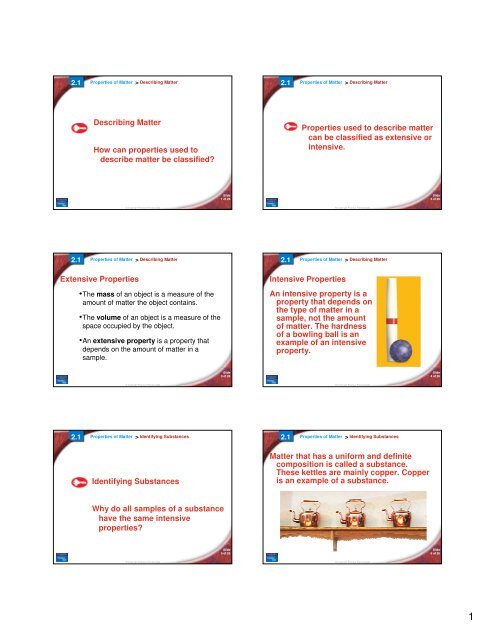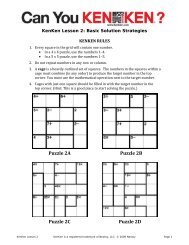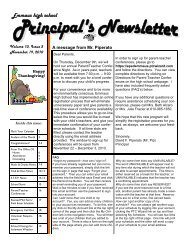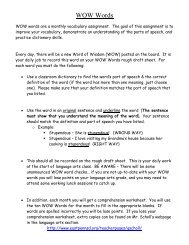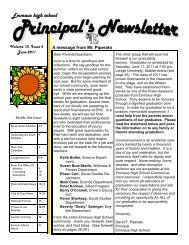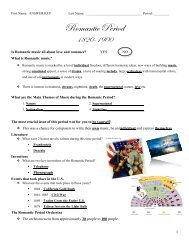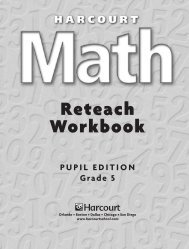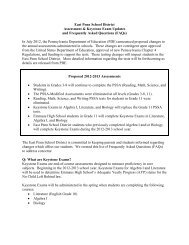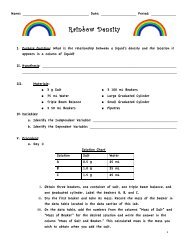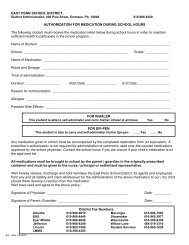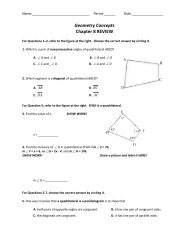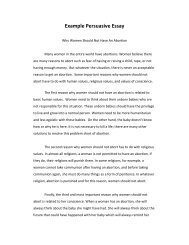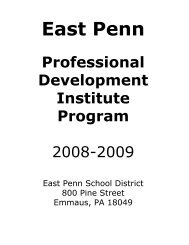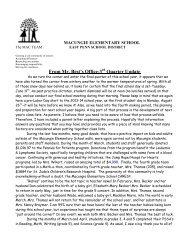ch2-ppt-notes
ch2-ppt-notes
ch2-ppt-notes
Create successful ePaper yourself
Turn your PDF publications into a flip-book with our unique Google optimized e-Paper software.
2.1<br />
Properties of Matter > Describing Matter<br />
2.1<br />
Properties of Matter > Describing Matter<br />
Describing Matter<br />
How can properties used to<br />
describe matter be classified?<br />
Properties used to describe matter<br />
can be classified as extensive or<br />
intensive.<br />
Slide<br />
1 of 26<br />
Slide<br />
2 of 26<br />
© Copyright Pearson Prentice Hall<br />
© Copyright Pearson Prentice Hall<br />
2.1<br />
Properties of Matter > Describing Matter<br />
2.1<br />
Properties of Matter > Describing Matter<br />
Extensive Properties<br />
•The mass of an object is a measure of the<br />
amount of matter the object contains.<br />
•The volume of an object is a measure of the<br />
space occupied by the object.<br />
•An extensive property is a property that<br />
depends on the amount of matter in a<br />
sample.<br />
Intensive Properties<br />
An intensive property is a<br />
property that depends on<br />
the type of matter in a<br />
sample, not the amount<br />
of matter. The hardness<br />
of a bowling ball is an<br />
example of an intensive<br />
property.<br />
Slide<br />
3 of 26<br />
Slide<br />
4 of 26<br />
© Copyright Pearson Prentice Hall<br />
© Copyright Pearson Prentice Hall<br />
2.1<br />
Properties of Matter > Identifying Substances<br />
2.1<br />
Properties of Matter > Identifying Substances<br />
Identifying Substances<br />
Matter that has a uniform and definite<br />
composition is called a substance.<br />
These kettles are mainly copper. Copper<br />
is an example of a substance.<br />
Why do all samples of a substance<br />
have the same intensive<br />
properties?<br />
Slide<br />
5 of 26<br />
Slide<br />
6 of 26<br />
© Copyright Pearson Prentice Hall<br />
© Copyright Pearson Prentice Hall<br />
1
2.1<br />
Properties of Matter > Identifying Substances<br />
2.1<br />
Properties of Matter > Identifying Substances<br />
Every sample of a given substance<br />
has identical intensive properties<br />
because every sample has the<br />
same composition.<br />
A physical property is a quality or<br />
condition of a substance that can be<br />
observed or measured without changing<br />
the substance’s composition.<br />
Hardness, color, conductivity, and<br />
malleability are examples of physical<br />
properties.<br />
Slide<br />
7 of 26<br />
Slide<br />
8 of 26<br />
© Copyright Pearson Prentice Hall<br />
© Copyright Pearson Prentice Hall<br />
2.1<br />
Properties of Matter > Identifying Substances<br />
2.1<br />
Properties of Matter > States of Matter<br />
States of Matter<br />
What are three states of matter?<br />
Slide<br />
9 of 26<br />
Slide<br />
10 of 26<br />
© Copyright Pearson Prentice Hall<br />
© Copyright Pearson Prentice Hall<br />
Properties of Matter ><br />
2.1<br />
Properties of Matter > States of Matter<br />
Pennsylvania, Deleware, New<br />
York<br />
Sometimes New Jersey<br />
Three states of matter are solid,<br />
liquid, and gas.<br />
Slide<br />
11 of 26<br />
Slide<br />
12 of 26<br />
© Copyright Pearson Prentice Hall<br />
© Copyright Pearson Prentice Hall<br />
2
2.1<br />
Properties of Matter > States of Matter<br />
2.1<br />
Properties of Matter > States of Matter<br />
Solids<br />
A solid is a form of<br />
matter that has a<br />
definite shape and<br />
volume.<br />
Liquid<br />
A liquid is a form of<br />
matter that has an<br />
indefinite shape, flows,<br />
yet has a fixed volume.<br />
Slide<br />
13 of 26<br />
Slide<br />
14 of 26<br />
© Copyright Pearson Prentice Hall<br />
© Copyright Pearson Prentice Hall<br />
2.1<br />
Properties of Matter > States of Matter<br />
2.1<br />
Properties of Matter > States of Matter<br />
Gases<br />
A gas is a form of matter<br />
that takes both the<br />
shape and volume of<br />
its container.<br />
Vapor describes the gaseous state<br />
of a substance that is generally a<br />
liquid or solid at room<br />
temperature, as in water vapor.<br />
Slide<br />
15 of 26<br />
Slide<br />
16 of 26<br />
© Copyright Pearson Prentice Hall<br />
© Copyright Pearson Prentice Hall<br />
2.1<br />
Properties of Matter > Physical Changes<br />
Physical Changes<br />
How can physical changes be<br />
classified?<br />
2.1<br />
Properties of Matter > Physical Changes<br />
During a physical change,<br />
some properties of a<br />
material change, but the<br />
composition of the<br />
material does not change.<br />
As gallium melts in a<br />
person’s hand, the shape<br />
of the sample changes,<br />
but the composition of<br />
the material does not<br />
change.<br />
Slide<br />
17 of 26<br />
Slide<br />
18 of 26<br />
© Copyright Pearson Prentice Hall<br />
© Copyright Pearson Prentice Hall<br />
3
2.1<br />
Properties of Matter > Physical Changes<br />
2.1 Section Quiz.<br />
Physical changes can be classified as<br />
reversible or irreversible.<br />
• All physical changes that involve a<br />
change from one state to another are<br />
reversible.<br />
• Cutting hair, filing nails, and cracking<br />
an egg are examples of irreversible<br />
physical changes.<br />
Assess students’ understanding<br />
of the concepts in Section 2.1.<br />
Continue to:<br />
Launch:<br />
-or-<br />
Section Quiz<br />
Slide<br />
19 of 26<br />
Slide<br />
20 of 26<br />
© Copyright Pearson Prentice Hall<br />
© Copyright Pearson Prentice Hall<br />
2.1 Section Quiz.<br />
1.Which of the following would be described as<br />
an extensive property of matter?<br />
a. temperature<br />
b. color<br />
c. mass<br />
d. hardness<br />
2.1 Section Quiz.<br />
2.Which properties can be observed without<br />
changing the composition of a substance?<br />
a. all properties of a substance<br />
b. intensive properties<br />
c. chemical properties<br />
d. physical properties<br />
Slide<br />
21 of 26<br />
Slide<br />
22 of 26<br />
© Copyright Pearson Prentice Hall<br />
© Copyright Pearson Prentice Hall<br />
2.1 Section Quiz.<br />
3.Match the states of matter with the following<br />
descriptions:<br />
(1) takes the volume and shape of its container<br />
(2) has a definite shape and volume<br />
(3) has a definite volume but an indefinite shape<br />
END OF SHOW<br />
a. (1) liquid, (2) solid and (3) gas<br />
b. (1) gas, (2) solid, and (3) liquid<br />
c. (1) gas, (2) liquid, and (3) solid<br />
Slide<br />
23 of 26<br />
© Copyright Pearson Prentice Hall<br />
4
2.2<br />
Mixtures<br />
> Classifying Mixtures<br />
2.2<br />
Mixtures<br />
> Classifying Mixtures<br />
Classifying Mixtures<br />
How can mixtures be classified?<br />
A mixture is a physical blend of two or<br />
more components.<br />
A salad bar provides a range of items.<br />
Customers choose how much of each<br />
item to use in their salads. Each salad<br />
has a different composition.<br />
Slide<br />
1 of 21<br />
Slide<br />
2 of 21<br />
© Copyright Pearson Prentice Hall<br />
© Copyright Pearson Prentice Hall<br />
2.2<br />
Mixtures<br />
> Classifying Mixtures<br />
2.2<br />
Mixtures<br />
> Classifying Mixtures<br />
Heterogeneous Mixtures<br />
Based on the distribution of their<br />
components, mixtures can be<br />
classified as heterogeneous<br />
mixtures or as homogeneous<br />
mixtures.<br />
A mixture in which the composition is<br />
not uniform throughout is a<br />
heterogeneous mixture.<br />
Slide<br />
3 of 21<br />
Slide<br />
4 of 21<br />
© Copyright Pearson Prentice Hall<br />
© Copyright Pearson Prentice Hall<br />
2.2<br />
Mixtures<br />
> Classifying Mixtures<br />
2.2 Mixtures > Classifying Mixtures<br />
Homogeneous Mixtures<br />
A mixture in which the composition is<br />
uniform throughout is a homogeneous<br />
mixture.<br />
Another name for a homogeneous<br />
mixture is a solution.<br />
The term phase is used to describe<br />
any part of a sample with uniform<br />
composition and properties.<br />
• A homogenous mixture consists<br />
of a single phase.<br />
• A heterogeneous mixture consists of<br />
two or more phases.<br />
Slide<br />
5 of 21<br />
Slide<br />
6 of 21<br />
© Copyright Pearson Prentice Hall<br />
© Copyright Pearson Prentice Hall<br />
1
2.2 Mixtures > Classifying Mixtures<br />
When oil and vinegar are mixed they form<br />
layers, or phases. The oil phase floats on<br />
the water phase.<br />
Slide<br />
7 of 21<br />
Slide<br />
8 of 21<br />
© Copyright Pearson Prentice Hall<br />
© Copyright Pearson Prentice Hall<br />
2.2 Mixtures > Separating Mixtures<br />
Separating Mixtures<br />
How can mixtures be separated?<br />
Slide<br />
9 of 21<br />
Slide<br />
10 of 21<br />
© Copyright Pearson Prentice Hall<br />
© Copyright Pearson Prentice Hall<br />
2.2<br />
Mixtures<br />
> Separating Mixtures<br />
2.2<br />
Mixtures<br />
> Separating Mixtures<br />
Filtration<br />
Differences in physical properties<br />
can be used to separate<br />
mixtures.<br />
The process that separates a solid from the<br />
liquid in a heterogeneous mixture is<br />
called filtration.<br />
A colander is used to separate pasta from<br />
the water in which it was cooked. This<br />
process is a type of filtration.<br />
Slide<br />
11 of 21<br />
Slide<br />
12 of 21<br />
© Copyright Pearson Prentice Hall<br />
© Copyright Pearson Prentice Hall<br />
2
2.2<br />
Mixtures<br />
Distillation<br />
> Separating Mixtures<br />
During a distillation, a liquid is boiled to<br />
produce a vapor that is then condensed<br />
into a liquid.<br />
2.2 Section Quiz.<br />
Assess students’ understanding<br />
of the concepts in Section 2.2.<br />
Continue to:<br />
-or-<br />
Launch:<br />
Section Quiz<br />
Slide<br />
13 of 21<br />
Slide<br />
14 of 21<br />
© Copyright Pearson Prentice Hall<br />
© Copyright Pearson Prentice Hall<br />
2.2 Section Quiz.<br />
1.Which of the following phrases describes a<br />
mixture?<br />
a. composition varies<br />
b. composition may vary<br />
c. components cannot be separated<br />
2.2 Section Quiz.<br />
2.Which of the following is a homogeneous<br />
mixture?<br />
a. vinegar<br />
b. iron filings in sand<br />
c. chicken noodle soup<br />
d. muddy water<br />
Slide<br />
15 of 21<br />
Slide<br />
16 of 21<br />
© Copyright Pearson Prentice Hall<br />
© Copyright Pearson Prentice Hall<br />
2.2 Section Quiz.<br />
3.Which technique is used to separate<br />
homogeneous mixtures?<br />
a. filtration<br />
b. distillation<br />
END OF SHOW<br />
c. magnetism<br />
d. dissolving<br />
Slide<br />
17 of 21<br />
© Copyright Pearson Prentice Hall<br />
3
2.3<br />
3<br />
Elements and Compounds > Distinguishing Elements and<br />
Compounds<br />
2.3<br />
Elements and Compounds > Distinguishing Elements and<br />
Compounds<br />
Distinguishing Elements and<br />
Compounds<br />
How are elements and<br />
compounds different?<br />
An element is the simplest form of matter<br />
that has a unique set of properties.<br />
A compound is a substance that contains<br />
two or more elements chemically<br />
combined in a fixed proportion.<br />
Slide<br />
1 of 25<br />
Slide<br />
2 of 25<br />
© Copyright Pearson Prentice Hall<br />
© Copyright Pearson Prentice Hall<br />
2.3<br />
Elements and Compounds > Distinguishing Elements and<br />
Compounds<br />
2.3<br />
Elements and Compounds > Distinguishing Elements and<br />
Compounds<br />
Breaking Down<br />
Compounds<br />
Compounds can be broken down<br />
into simpler substances by<br />
chemical means, but elements<br />
cannot.<br />
A chemical change is a<br />
change that produces<br />
matter with a different<br />
composition than the<br />
original matter.<br />
Slide<br />
3 of 25<br />
When table sugar is<br />
heated, it goes through<br />
a series of chemical<br />
changes.<br />
Slide<br />
4 of 25<br />
© Copyright Pearson Prentice Hall<br />
© Copyright Pearson Prentice Hall<br />
2.3<br />
Elements and Compounds > Distinguishing Elements and<br />
Compounds<br />
2.3<br />
Elements and Compounds > Distinguishing Elements and<br />
Compounds<br />
The final products of these chemical<br />
changes are solid carbon and water<br />
vapor. The following diagram<br />
summarizes the process.<br />
Properties of Compounds<br />
In general, the properties of compounds<br />
are quite different from those of their<br />
component elements.<br />
When the elements sodium and chlorine<br />
combine chemically to form sodium<br />
chloride, there is a change in<br />
composition and a change in properties.<br />
Slide<br />
5 of 25<br />
Slide<br />
6 of 25<br />
© Copyright Pearson Prentice Hall<br />
© Copyright Pearson Prentice Hall<br />
1
2.3<br />
Elements and Compounds > Distinguishing Elements and<br />
Compounds<br />
2.3<br />
Elements and Compounds > Distinguishing Elements and<br />
Compounds<br />
Chlorine is used to kill<br />
harmful organisms<br />
in swimming pools.<br />
Sodium is stored<br />
under oil to keep<br />
it from reacting<br />
with oxygen or<br />
water vapor in<br />
the air. Sodium<br />
vapor produces<br />
the light in some<br />
street lamps.<br />
Slide<br />
7 of 25<br />
Slide<br />
8 of 25<br />
© Copyright Pearson Prentice Hall<br />
© Copyright Pearson Prentice Hall<br />
2.3<br />
Elements and Compounds > Distinguishing Elements and<br />
Compounds<br />
2.3<br />
Elements and Compounds > Distinguishing Substances and<br />
Mixtures<br />
Sodium Chloride<br />
(commonly<br />
known as table<br />
salt) is used to<br />
season or<br />
preserve food.<br />
Distinguishing Substances and<br />
Mixtures<br />
How can substances and mixtures be<br />
distinguished?<br />
Slide<br />
9 of 25<br />
Slide<br />
10 of 25<br />
© Copyright Pearson Prentice Hall<br />
© Copyright Pearson Prentice Hall<br />
2.3<br />
Elements and Compounds > Distinguishing Substances and<br />
Mixtures<br />
2.3<br />
Elements and Compounds > Distinguishing Substances<br />
and Mixtures<br />
If the composition of a material is fixed,<br />
the material is a substance.<br />
This flowchart<br />
summarizes the<br />
process for<br />
classifying matter.<br />
If the composition of a material may vary,<br />
the material is a mixture.<br />
Slide<br />
11 of 25<br />
Slide<br />
12 of 25<br />
© Copyright Pearson Prentice Hall<br />
© Copyright Pearson Prentice Hall<br />
2
2.3<br />
3<br />
Elements and Compounds > Symbols and Formulas<br />
2.3<br />
Elements and Compounds > Symbols and Formulas<br />
Symbols and Formulas<br />
What do chemists use to<br />
represent elements and<br />
compounds?<br />
Chemists use chemical symbols to<br />
represent elements, and chemical<br />
formulas to represent compounds.<br />
These chemical symbols were used in<br />
earlier centuries.<br />
Waldo<br />
Slide<br />
13 of 25<br />
Slide<br />
14 of 25<br />
© Copyright Pearson Prentice Hall<br />
© Copyright Pearson Prentice Hall<br />
2.3<br />
Elements and Compounds > Symbols and Formulas<br />
2.3 Section Quiz.<br />
Each element is represented by a one or<br />
two-letter chemical symbol.<br />
Assess students’ understanding<br />
of the concepts in Section 2.3.<br />
Continue to:<br />
Section Quiz<br />
-or-<br />
Launch:<br />
Slide<br />
15 of 25<br />
Slide<br />
16 of 25<br />
© Copyright Pearson Prentice Hall<br />
© Copyright Pearson Prentice Hall<br />
2.3 Section Quiz<br />
1.Passing an electric current through a certain<br />
substance produces oxygen and sulfur. This<br />
substance cannot be a(n)<br />
a. compound.<br />
b. mixture.<br />
c. element.<br />
d. solution.<br />
2.3 Section Quiz<br />
2.Which of the following is a mixture?<br />
a. sodium chloride<br />
b. carbon dioxide<br />
c. sucrose<br />
d. air<br />
Slide<br />
17 of 25<br />
Slide<br />
18 of 25<br />
© Copyright Pearson Prentice Hall<br />
© Copyright Pearson Prentice Hall<br />
3
2.3 Section Quiz.<br />
3.The symbol for the element potassium is<br />
a. K.<br />
b. Po.<br />
c. P.<br />
END OF SHOW<br />
d. Pt.<br />
Slide<br />
19 of 25<br />
© Copyright Pearson Prentice Hall<br />
4
2.4<br />
3<br />
Chemical Reactions > Chemical Changes<br />
2.4<br />
Chemical Reactions > Chemical Changes<br />
Chemical Changes<br />
What always happens during a<br />
chemical change?<br />
The ability of a substance to undergo a<br />
specific chemical change is called a<br />
chemical property.<br />
Chemical properties can be used to<br />
identify a substance. But chemical<br />
properties can be observed only when a<br />
substance undergoes a chemical<br />
change.<br />
Slide<br />
1 of 19<br />
Slide<br />
2 of 19<br />
© Copyright Pearson Prentice Hall<br />
© Copyright Pearson Prentice Hall<br />
2.4<br />
Chemical Reactions > Chemical Changes<br />
2.4<br />
Chemical Reactions > Chemical Changes<br />
During a chemical change, the<br />
composition of matter always<br />
changes.<br />
A magnet separates iron from sulfur. This<br />
is an example of a physical change.<br />
Recall that during a physical change,<br />
the composition of matter never<br />
changes.<br />
Slide<br />
3 of 19<br />
Slide<br />
4 of 19<br />
© Copyright Pearson Prentice Hall<br />
© Copyright Pearson Prentice Hall<br />
2.4<br />
Chemical Reactions > Chemical Changes<br />
2.4<br />
Chemical Reactions > Chemical Changes<br />
A mixture of iron and sulfur is heated. The<br />
iron and sulfur react and form iron<br />
sulfide. This is an example of a chemical<br />
change.<br />
• A chemical change is also called a chemical<br />
reaction.<br />
• One or more substances change into one or<br />
more new substances during a chemical<br />
reaction.<br />
• A substance present at the start of the<br />
reaction is a reactant.<br />
Slide<br />
5 of 19<br />
• A substance produced in the reaction is a<br />
product.<br />
Slide<br />
6 of 19<br />
© Copyright Pearson Prentice Hall<br />
© Copyright Pearson Prentice Hall<br />
1
2.4<br />
Chemical Reactions > Recognizing Chemical Changes<br />
2.4<br />
Chemical Reactions > Recognizing Chemical Changes<br />
Recognizing Chemical Changes<br />
What are four possible clues that a chemical<br />
change has taken place?<br />
Possible clues to chemical change<br />
include:<br />
• a transfer of energy<br />
• a change in color<br />
• the production of a gas<br />
• the formation of a precipitate.<br />
Slide<br />
7 of 19<br />
Slide<br />
8 of 19<br />
© Copyright Pearson Prentice Hall<br />
© Copyright Pearson Prentice Hall<br />
2.4<br />
Chemical Reactions > Chemical Changes<br />
2.4<br />
Chemical Reactions > Conservation of Mass<br />
A precipitate is a solid that forms and<br />
settles out of a liquid mixture.<br />
Clues to chemical changes have practical<br />
applications.<br />
Conservation of Mass<br />
How are the mass of the reactants and<br />
the mass of the products of a chemical<br />
reaction related?<br />
Slide<br />
9 of 19<br />
Slide<br />
10 of 19<br />
© Copyright Pearson Prentice Hall<br />
© Copyright Pearson Prentice Hall<br />
2.4<br />
Chemical Reactions > Conservation of Mass<br />
2.4<br />
Chemical Reactions > Conservation of Mass<br />
During any chemical reaction, the mass of<br />
the products is always equal to the mass of<br />
the reactants.<br />
The law of conservation of mass states<br />
that in any physical change or chemical<br />
reaction, mass is conserved.<br />
The conservation of mass is easily<br />
observed when a change occurs in a<br />
closed container.<br />
Slide<br />
11 of 19<br />
Slide<br />
12 of 19<br />
© Copyright Pearson Prentice Hall<br />
© Copyright Pearson Prentice Hall<br />
2
2.4 Section Quiz.<br />
Assess students’ understanding<br />
of the concepts in Section 2.4.<br />
Continue to:<br />
Launch:<br />
-or-<br />
Section Quiz<br />
2.4 Section Quiz.<br />
1.Which of the following is a chemical reaction?<br />
a. melting of lead<br />
b. dissolving sugar in water<br />
c. rusting of iron<br />
d. crushing of stone<br />
Slide<br />
13 of 19<br />
Slide<br />
14 of 19<br />
© Copyright Pearson Prentice Hall<br />
© Copyright Pearson Prentice Hall<br />
2.4 Section Quiz.<br />
2.Which of the following is NOT a possible clue<br />
that a chemical change is taking place?<br />
a. a change of state<br />
b. a change in color<br />
c. production of a gas<br />
d. formation of a precipitate<br />
Slide<br />
15 of 19<br />
2.4 Section Quiz.<br />
3.During any chemical change, the mass of the<br />
products is<br />
a. always equal to the mass of the reactants.<br />
b. always greater than the mass of the<br />
reactants.<br />
c. always less than the mass of the reactants.<br />
d. sometimes different than the mass of the<br />
reactants.<br />
Slide<br />
16 of 19<br />
© Copyright Pearson Prentice Hall<br />
© Copyright Pearson Prentice Hall<br />
Chemical Reactions > Concept Map 2<br />
Concept Map 2 Solve the Concept Map with the help<br />
of an interactive guided tutorial.<br />
END OF SHOW<br />
Slide<br />
17 of 19<br />
© Copyright Pearson Prentice Hall<br />
3


